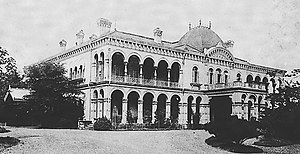Rocumeican

Rokumeikan ( Japanese 鹿鳴 館 , literally: "Deer-Ruf pavilion") was the name of a building erected in 1883 in the Kōjimachi district of the then Tokyo Prefecture (now the Chiyoda district of the metropolis of Tokyo), which symbolized the westernization of Japan in the Meiji -Time became.
background
The two-story building was designed by the architect Josiah Conder in 1880 at the request of Foreign Minister Inoue Kaoru (1835–1915) . Conder, one of the "foreign contractors" ( o-yatoi gaikokujin ) employed by the government at the time , mixed Japanese and Western elements. The entrepreneur Ōkura Kihachirō was one of the financial supporters of the construction . The garden was laid out in a purely Japanese style.
The area near the Imperial Palace once belonged to the Satsuma fief . After the Meiji restoration , it was first used in preparation for the 1873 World's Fair (Vienna). Between 1875 and 1881 the "Museum behind the Yamashita Gate" ( 山下 門内 博物館 , Yamashitamon-nai hakubutsukan ) with seven buildings for plants, animals, minerals, antiques, etc. was also there, a greenhouse and various buildings for animal breeding. These facilities were then relocated to what is now the Ueno Park .
use
1200 guests were invited to the opening gala on November 28, 1883. The building managed by the Ministry of Foreign Affairs was used to accommodate foreign government guests. Japanese people who had lived abroad also met here. In addition, lavish banquets were given with menus in French. There were also garden parties and charity bazaars. The ballroom on the first floor danced to the latest tunes.
The reactions of western guests were divided. Pierre Loti , who came to Japan in 1886 and took part in a “Ball in Edo ” (“ Un bal a Yeddo ”), was reminded of a mediocre casino in a French seaside resort in his “Japoneries d'Automne” (1889). His compatriot Georges Bigot published in the satirical journal Tôbaé (1887) the poisonous caricature of a Japanese couple, more poorly than well dressed according to Western fashion, reflected in the mirror in the shape of a monkey. Critical voices also came from conservative Japanese circles.
In 1887, the Meiji government decided to build a first-class western-style hotel. Among the sponsors we find the Foreign Minister Inoue again, along with the politician Ōkuma Shigenobu and the entrepreneur Shibusawa Eiichi . This neighboring Imperial Hotel ( Teikoku hoteru ), opened in 1890, quickly developed into Tokyo's new social hub. In the same year the Rokumei pavilion was sold. Subsequently, the building served under the name Kazoku-kaikan ( 華 族 会館 , "aristocratic hall") as a meeting place for the nobility ( kazoku ). In early 1891, after the first fire in the temporary Imperial Diet Building, the Upper House of the Imperial Diet ( Kizokuin ) met for a short time in the Kazoku-kaikan , but later moved to the Imperial Hotel for reasons of space. In 1927 it went to the insurance company Nippon Chōhei Hoken (later Yamato Seimei Hoken ). It was finally demolished in 1940. In the same place today stands the NBF Hibiya Building ( NBF 日 比 谷 ビ ル ), built in 1984 as the headquarters of the insurance company Yamato Seimei Hoken , where a plaque commemorates the Rokumei Pavilion.
Artistic processing
The Rokumeikan appears in Japanese stories, in a play, in films and also in mangas.
- Chijin no ai . 1924 ("Naomi or An Insatiable Love"). Novella by Tanizaki Jun'ichirō
- Butōkai . 1920 ("The Chrysanthemum Ball"). Short story by Akutagawa Ryūnosuke using Loti's descriptions
- Rocumeican . 1956. Four-stroke by Mishima Yukio
literature
- Pierre Loti: Japoneries d'Automne . Calmann-Lévy, 1889 ( digitized version ).
- Dallas Finn: Reassessing the Rokumeikan . In: Challenging past and present: the metamorphosis of nineteenth-century Japanese art . University of Hawaii Press, Honolulu 2006.
- Ian Buruma: Inventing Japan: 1853-1964 . Modern Library, 2004, ISBN 0-8129-7286-4 .
References and comments
- ↑ "Outline image of a dance by famous people" ( kiken butō no ryakuzu , 貴 顕 舞 踏 の 略 図 )
- ↑ The name goes back to the song Lù Míng ( 鹿鳴 ) in the Chinese Book of Songs ( Shījīng ), in which grazing deer give each other sound. The song was originally sung at banquets.
- ↑ Tōkyō-fu, Kōjimachi-ku, Yamashita-chō ( 東京 府 麹 町 区 山下 町 ), today Tōkyō-to, Chiyoda-ku, Uchisaiwai-chō ( 東京 都 千代 田 区内 幸 町 )
- ↑ The Yamashita Gate was one of the gates of the extensive ring complex of Edo Castle .
- ↑ Pierre Loti: "Japoneries d'Automne", 1889, SS 77-106.
- ↑ Sangiin , History of the Parliament Building: 仮 議事堂 ~ 現在 の 議事堂 が 建 て ら れ る ま で
- ↑ 鹿鳴 館 跡 . Chiyoda Tourism Association, accessed August 14, 2013 (Japanese).
Coordinates: 35 ° 40 ′ 18 ″ N , 139 ° 45 ′ 28 ″ E
